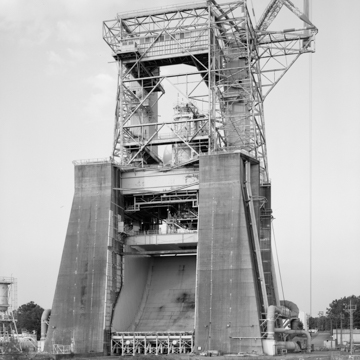You are here
Saturn Static Test Stand (S-1C)
The Saturn Static Test Stand, alternately known as the S-1C Test Stand, was designed and engineered for the Saturn V first stage booster. The stand is approximately 405 feet tall with a base of 164 x 164 feet in footprint. There are four concrete pylons rising at the corners of the stand with a 32-foot-deep substructure. Designed in 1961, the test stand was used to captive-fire the Saturn V (C-5) booster, the largest rocket then in development. The structure was designed to accommodate test articles up to 178 feet in length and 48 feet in diameter with up to 12 million pounds of thrust.
As of April 1965, NASA engineers ran short single-engine firings of the Saturn V at the Static Test Stand. Later that year the engineers tested the S-1C booster with five F-1 engines having a combined thrust of 7.5 million pounds. The first tests were 15-16 seconds in duration with later tests increased slowly to a full-length firing time of 2.5 minutes. Following Saturn testing at 4670, the stand was used for Space Shuttle and other advanced engine testing.
References
EDAW, Inc. Historical Assessment of Marshall Space Flight Center. Historic American Engineering Record, Division of Prints and Photographs, Library of Congress, Washington, DC, 2004.
Writing Credits
If SAH Archipedia has been useful to you, please consider supporting it.
SAH Archipedia tells the story of the United States through its buildings, landscapes, and cities. This freely available resource empowers the public with authoritative knowledge that deepens their understanding and appreciation of the built environment. But the Society of Architectural Historians, which created SAH Archipedia with University of Virginia Press, needs your support to maintain the high-caliber research, writing, photography, cartography, editing, design, and programming that make SAH Archipedia a trusted online resource available to all who value the history of place, heritage tourism, and learning.










